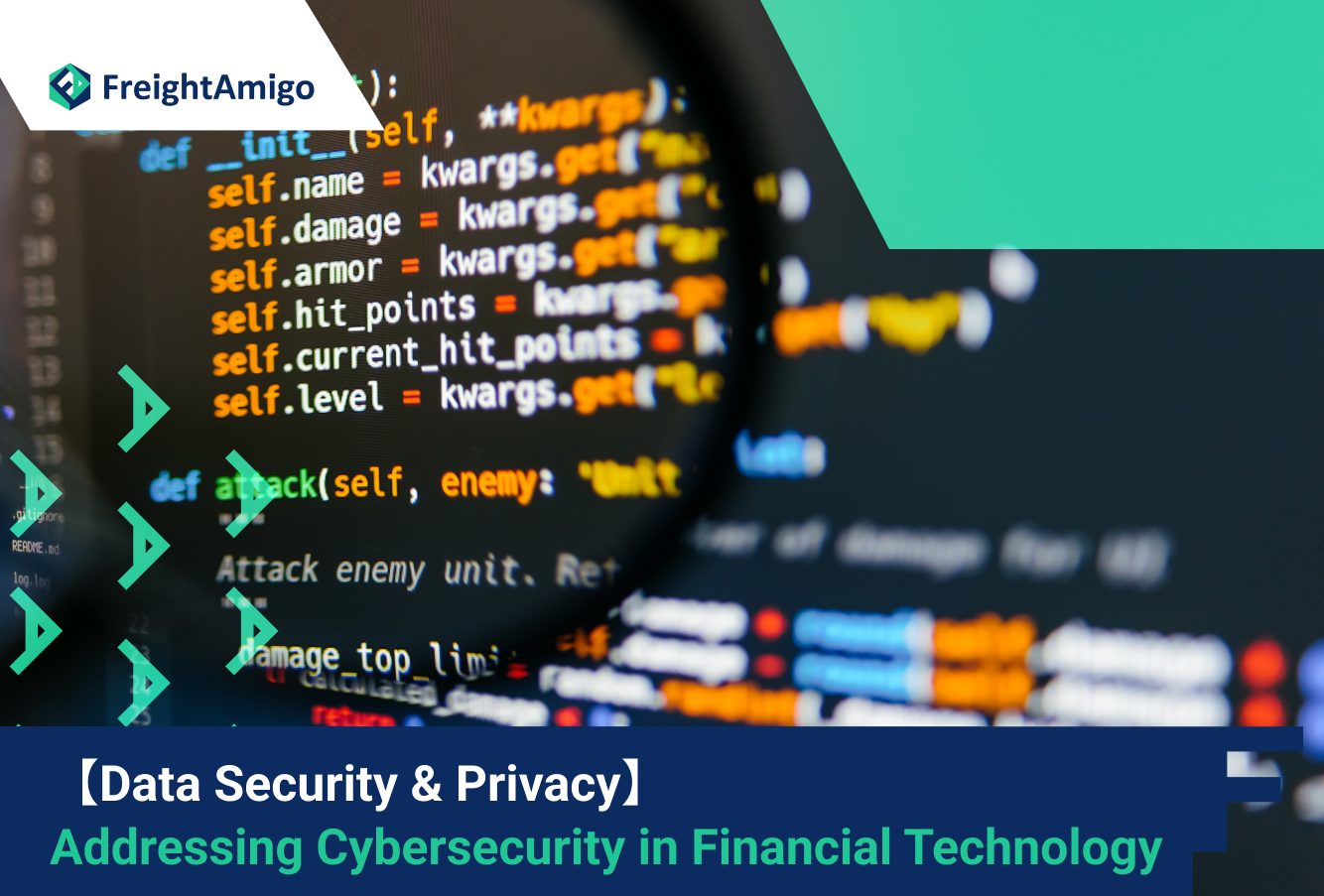Author Name: Maya Wong – Marketing Analyst at FreightAmigo
The rapid evolution of financial technology (fintech) has revolutionized the logistics and financial sectors, making transactions faster, more efficient, and more accessible. However, this digital revolution has also introduced new cybersecurity threats. This article explores the current fintech cybersecurity landscape, the challenges it presents, and the strategies for mitigating these risks.
Want To Compare The Best Express, Air Freight, Sea Freight, Rail Freight & Trucking Rates So As To Have Better Control On Cost?
The Rise of Financial Technology and Associated Cybersecurity Threats
Financial technology, or fintech, leverages cutting-edge technology to offer innovative financial services. It has transformed traditional banking and financial transactions, making them more convenient and user-friendly. However, this digital transformation has also brought to the fore new cybersecurity threats.
Fintech organizations handle vast amounts of sensitive client data, such as personal identity information, financial records, and transaction details. This data’s high value makes it a prime target for cybercriminals looking to exploit weaknesses and gain unauthorized access.
Key Trends in Fintech Cybersecurity
Several crucial trends in fintech cybersecurity have emerged.
Increased Cyber Attacks
Fintech firms are becoming increasingly vulnerable to cyber attacks. These include data breaches, ransomware attacks, and phishing attempts. Hackers exploit software flaws, infrastructure vulnerabilities, and human errors to gain unauthorized access to sensitive data or disrupt services.
Adoption of Cloud Services
To expand their operations and reduce costs, fintech organizations are increasingly adopting cloud computing. While cloud services offer flexibility and efficiency, they also introduce new security risks. Implementing robust cloud security measures such as encryption, access controls, and continuous monitoring is crucial to protect sensitive data.
Regulatory Focus
Global regulators are recognizing the importance of cybersecurity in the fintech industry. They are implementing regulations and procedures to ensure fintech firms comply with stringent security requirements and protect customer data. Compliance with regulations like the General Data Protection Regulation (GDPR) and the Payment Card Industry Data Security Standard (PCI DSS) is mandatory.
AI in Cybersecurity
Fintech organizations are leveraging artificial intelligence (AI) and machine learning technology to enhance their cybersecurity efforts. AI-powered systems can scan large volumes of data, identify patterns, and detect anomalies that may indicate cyber threats, aiding in the prevention and mitigation of potential security breaches.
Challenges in Fintech Cybersecurity
Alongside these trends, fintech cybersecurity presents several challenges.
Evolving Threat Landscape
Cybercriminals’ techniques are constantly evolving, making it challenging for fintech organizations to keep up with the ever-changing threat landscape. To stay ahead of cyber threats, fintech organizations must implement proactive security measures and continuously update their protection mechanisms.
Human Factor
Humans remain a weak link in cybersecurity. Employee training and awareness programs are critical for educating employees about cybersecurity best practices, such as identifying phishing emails, using strong passwords, and securely managing sensitive data.
Third-Party Risks
Fintech companies often work with third-party vendors and partners to provide their services. However, these collaborations can create additional security concerns if proper due diligence and vendor risk management policies are not in place. Fintech firms must ensure that their partners follow stringent security protocols.
Balancing Security and User Experience
Fintech organizations must strike the right balance between robust security and a smooth user experience. While stringent security measures, such as multi-factor authentication or complex password restrictions, must be implemented, it’s crucial to keep financial services user-friendly.
Managing Fintech Cybersecurity Risks
Addressing challenges and mitigating cybersecurity threats in the fintech industry requires a strategic approach.
Implementing Strong Cybersecurity Measures
Fintech organizations must implement robust cybersecurity measures such as encryption, access controls, firewalls, and intrusion detection systems. Regular vulnerability assessments and penetration testing can help identify and rectify potential flaws.
Continuous Monitoring
Proactive network and system monitoring is essential for swiftly identifying and responding to potential threats. Real-time monitoring, threat intelligence, and incident response protocols should be in place to mitigate the impact of cyberattacks.
Collaboration and Information Sharing
Fintech firms should collaborate with industry counterparts, share threat intelligence, and participate in information sharing forums. By collaborating, the industry can identify potential threats and develop effective countermeasures.
Employee Training and Awareness
Employees should be educated on cybersecurity best practices and made aware of potential dangers through regular training sessions. Topics covered should include phishing awareness, password hygiene, and social engineering strategies.
Regulatory Compliance
Fintech firms must comply with applicable laws and industry standards. Compliance with data protection laws, such as GDPR, is crucial to ensuring consumer information security and maintaining user trust.
Leveraging Blockchain Technology to Fortify Cybersecurity in Fintech
Blockchain technology offers a potent solution to counter cybersecurity threats in fintech. The immutable nature of blockchain provides a secure foundation for fintech companies to store and manage sensitive data. Once data is recorded on the blockchain, it becomes nearly impossible to alter or tamper with, ensuring the integrity and authenticity of financial transactions.
Decentralized Architecture and Distributed Consensus
Traditional fintech systems often rely on centralized servers, making them vulnerable to single points of failure and targeted cyber-attacks. In contrast, blockchain operates on a decentralized network of nodes, reducing the attack surface for hackers and enhancing system resilience.
Smart Contracts for Secure Transactions
Smart contracts, programmable agreements that automatically execute predefined actions when certain conditions are met, can enhance security in fintech transactions. By utilizing blockchain-based smart contracts, fintechs can establish trust, automate processes, and reduce the risk of fraud and errors.
Auditable and Transparent Systems
Blockchain’s transparent nature can enhance cybersecurity in fintech by providing auditable and transparent systems. All transactions recorded on the blockchain are visible to network participants, enabling real-time monitoring and detection of suspicious activities.
Conclusion
As the fintech industry continues to transform financial services, cybersecurity remains a top priority. Fintech firms must navigate an ever-changing threat landscape and tackle challenges associated with cybersecurity. By implementing robust security measures, leveraging technology such as AI and blockchain, and fostering a culture of awareness and collaboration, the fintech industry can strengthen its defenses and effectively secure customer information.
Maintaining trust in the digital financial ecosystem and promoting the continuous expansion and innovation of fintech requires ensuring cybersecurity resilience. The necessity of cybersecurity has never been stronger as the fintech industry continues to innovate and disrupt traditional financial services.
There Are Different Options For Cargo Transportation. If You Want To Choose The Most Convenient And Suitable Solution, It Is Best To Have The Full Support Of Logistics Experts! If You Are Planning To Ship Goods Overseas, Please Go To The FreightAmigo Page For Inquiries.
===
Read More:
【Digital Revolution】 Transforming the Future of Procurement in Supply Chain
【Embracing Blockchain】 A Revolutionary Leap in Streamlining Supply Chain Operations
【Transforming Transactions】 Transforming Transactions through Digital Wallets and Mobile Payments
===
If you have any inquiries on logistics/supply chain, feel free to contact FreightAmigo now:
Chat with us online OR
Phone : +852 28121686
WhatsApp: +852 27467829









































